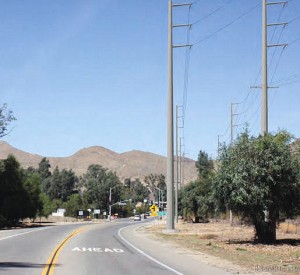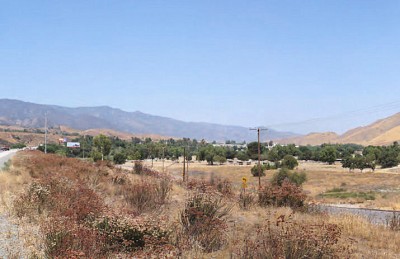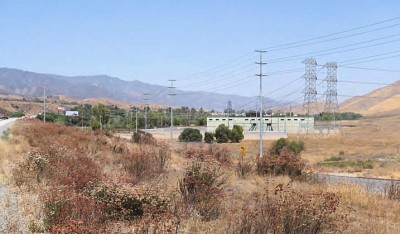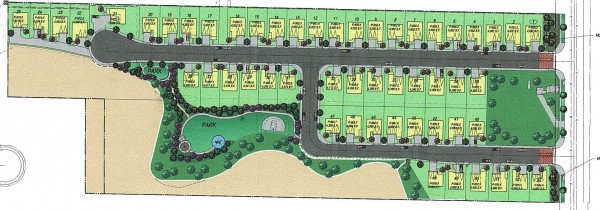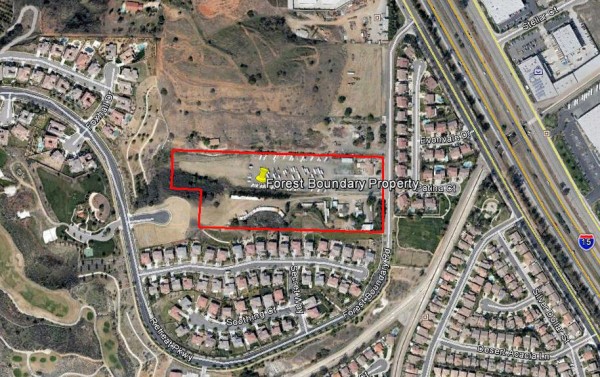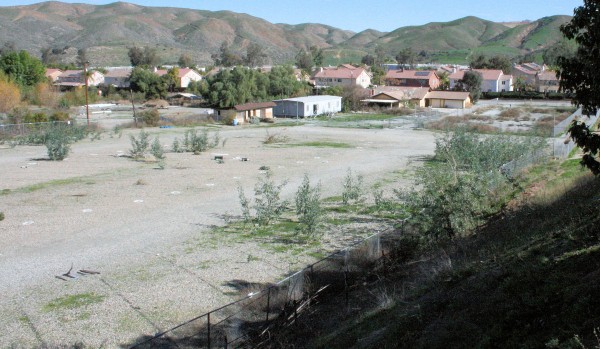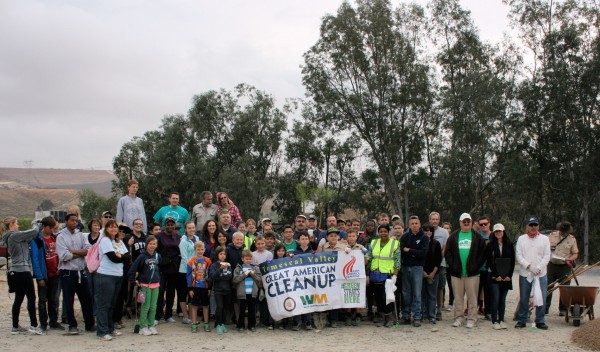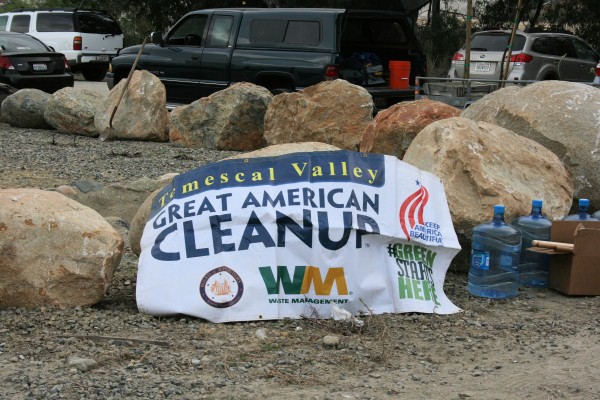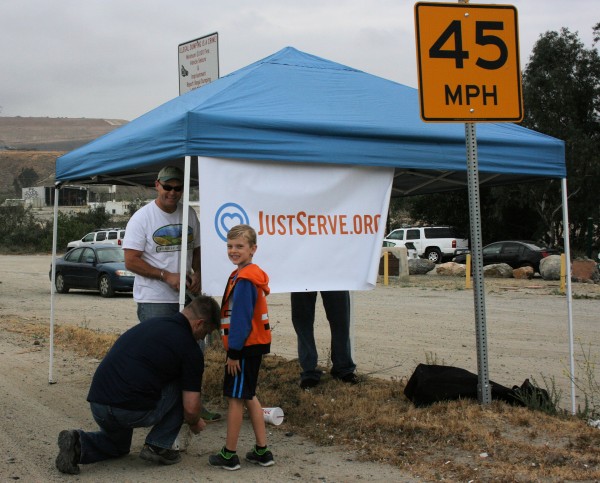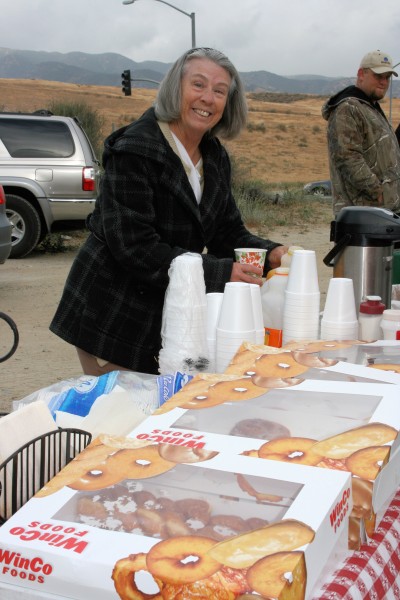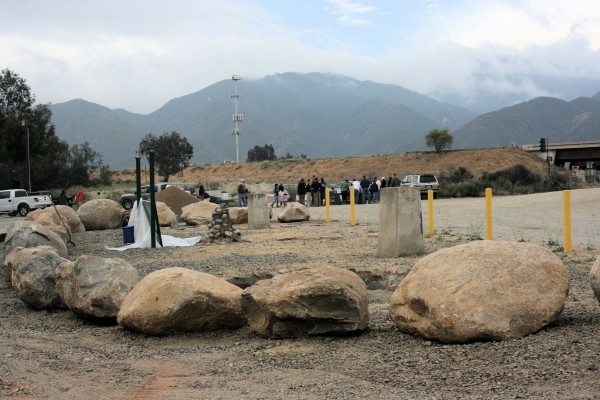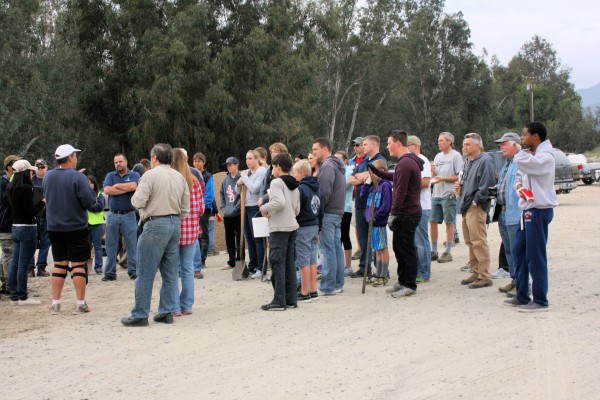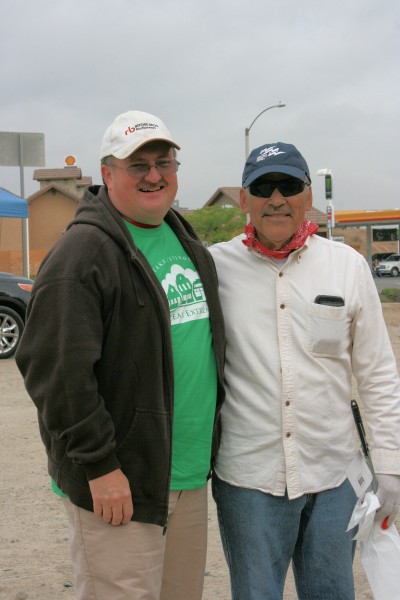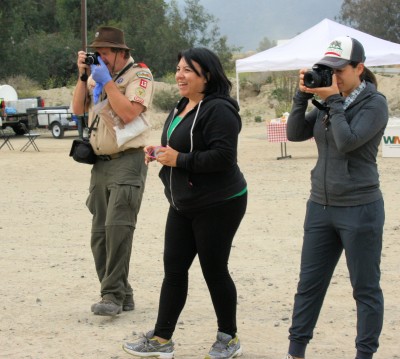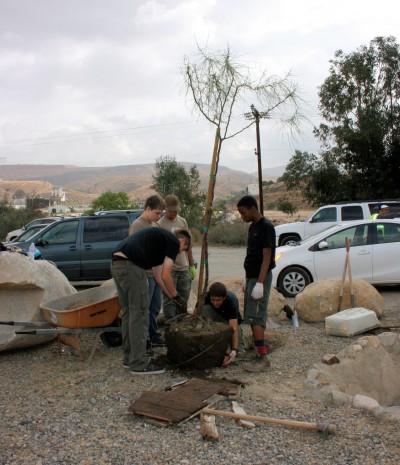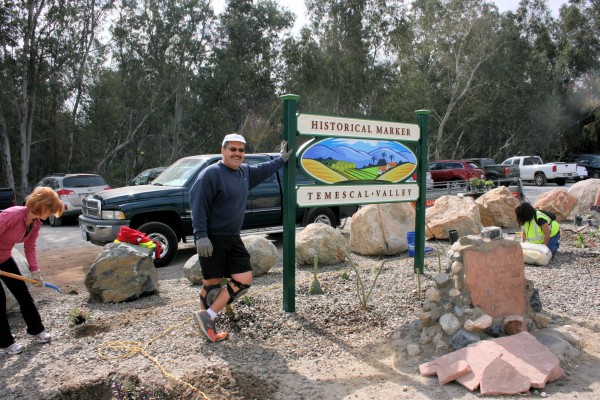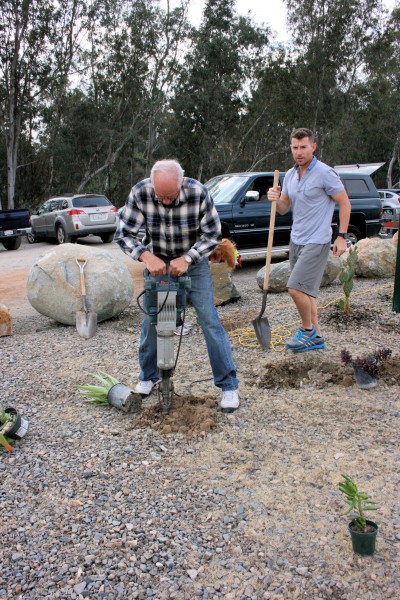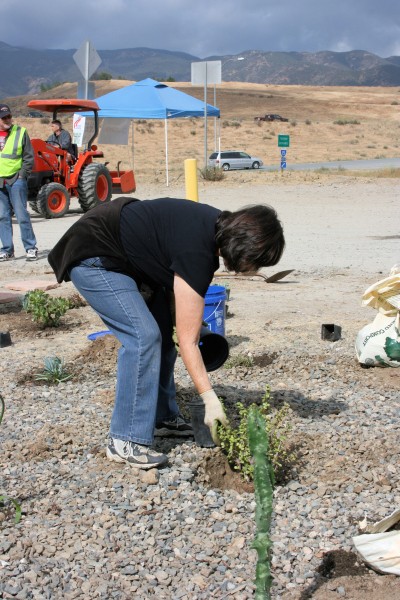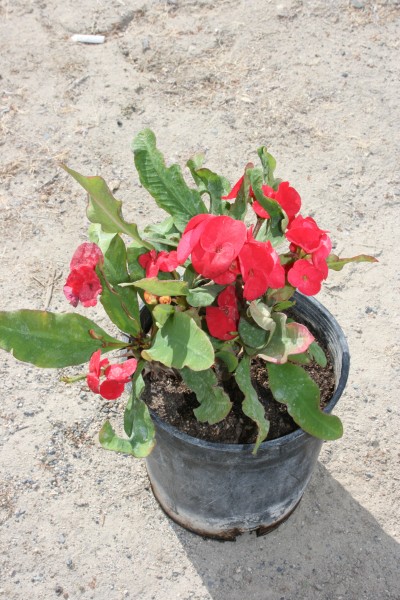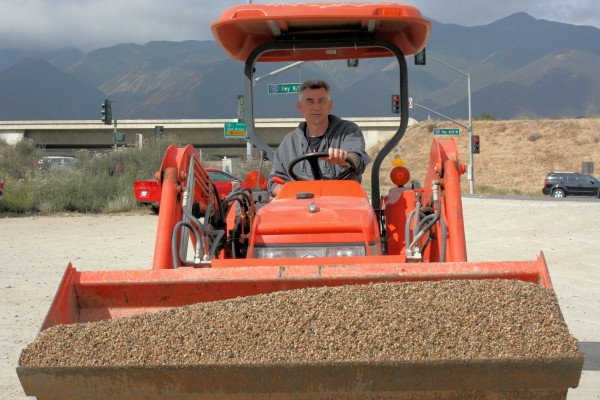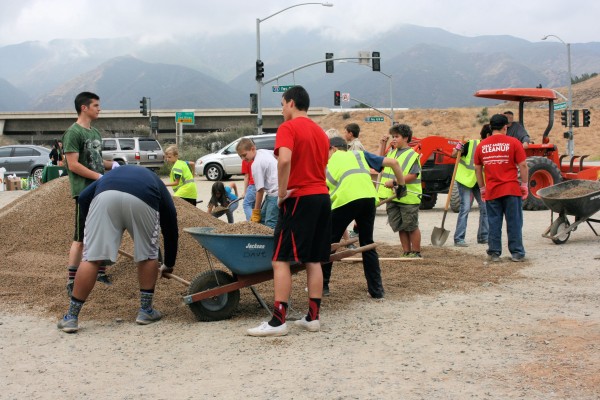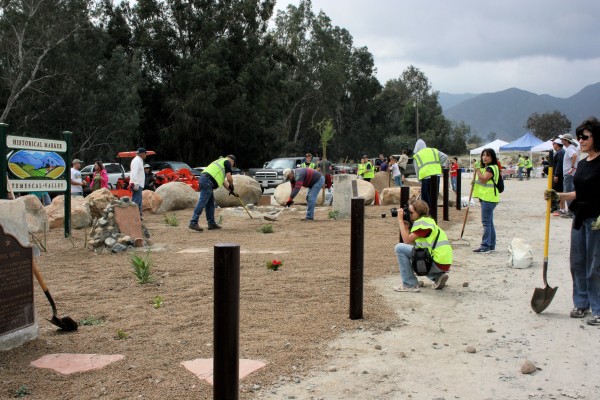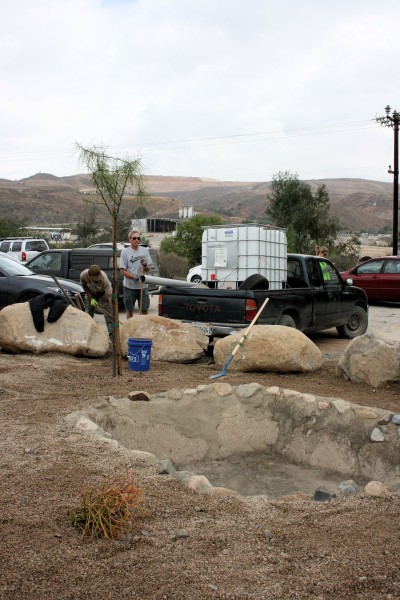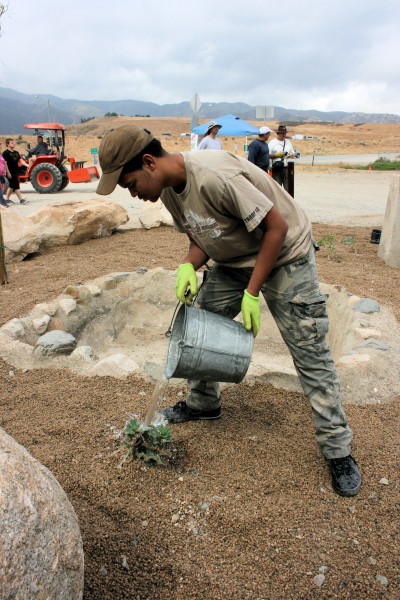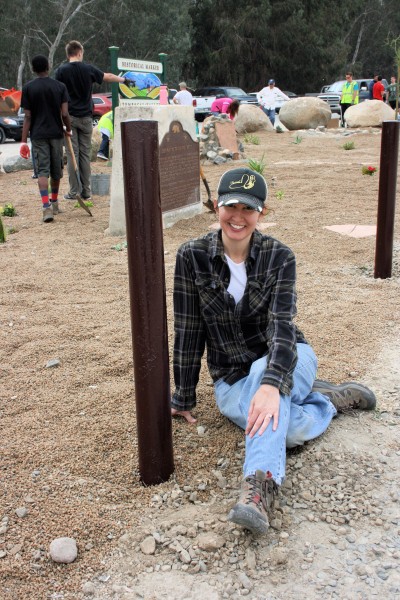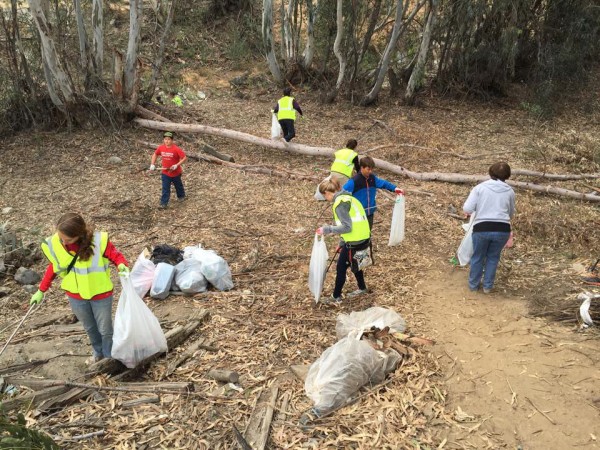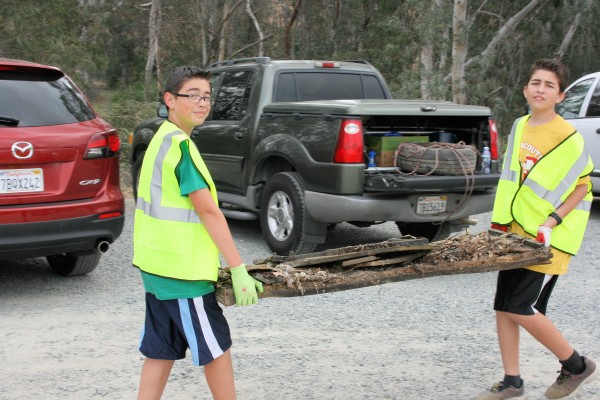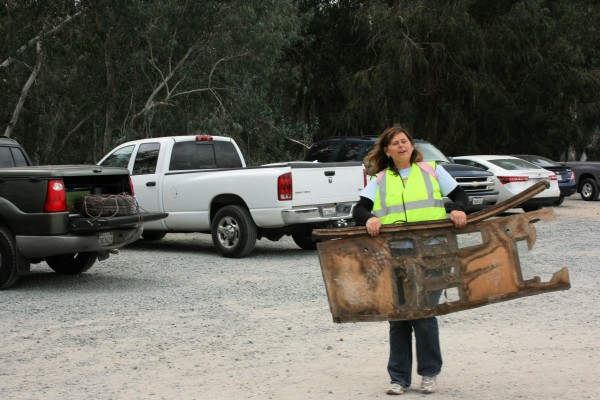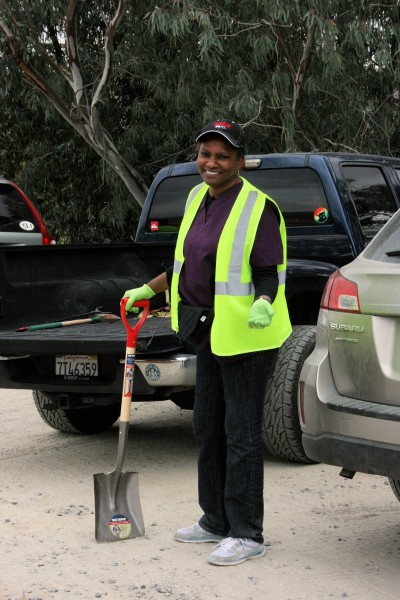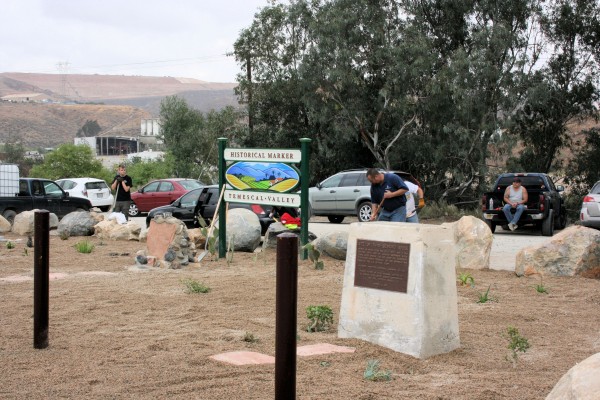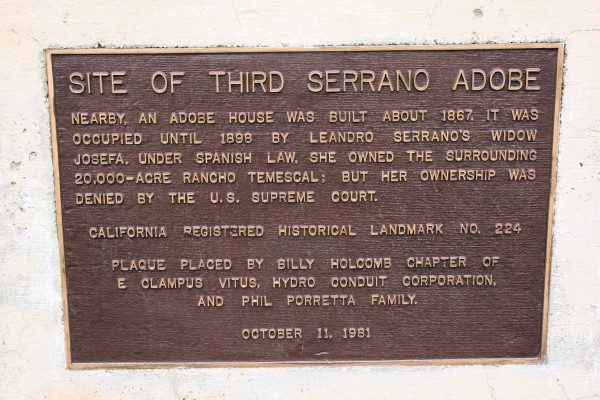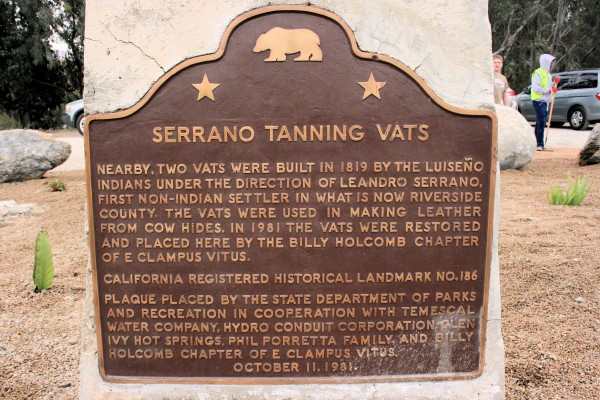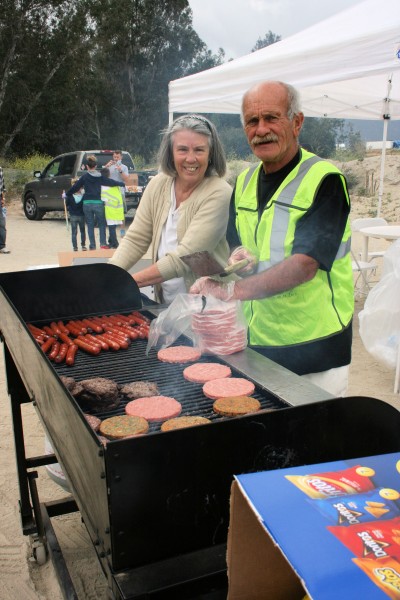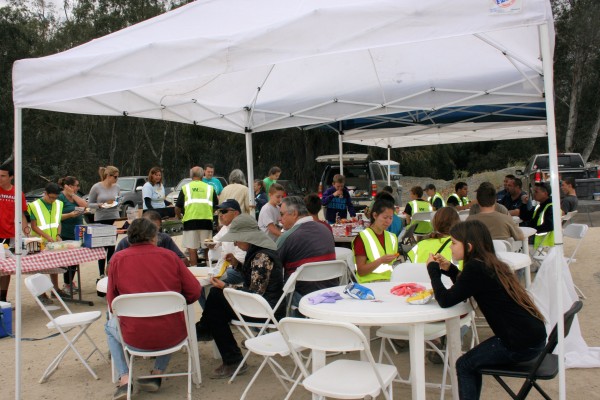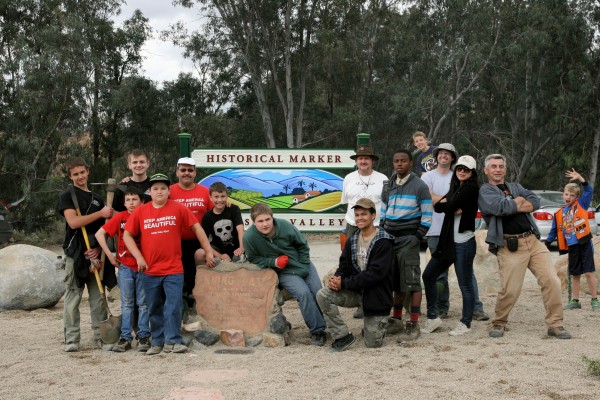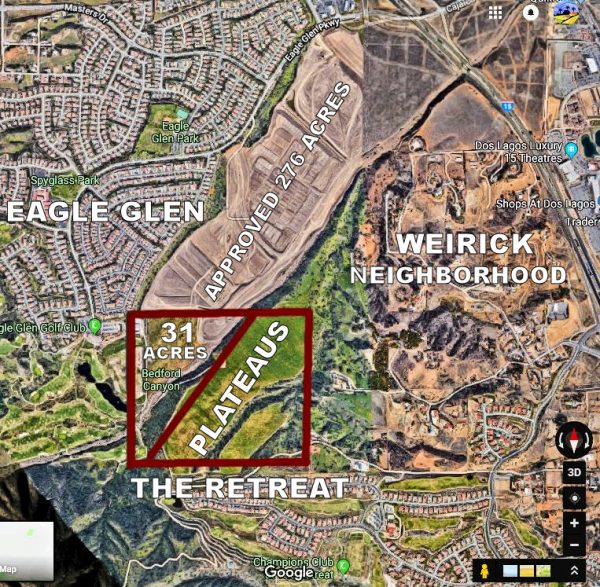
EXPANSION PLAN: The area outlined in red illustrates the 159-acre parcel that The New Home Company seeks to subdivide to add 31 acres to the already approved 276-acre Arantine Hills housing development. The developer is purchasing the 31 acres from the McMillan Trust. Plans by the developer and McMillian for the remaining 127 acres are unknown.
(Published Jan. 11. 2019)
The newly seated Corona City Council last month gave the go-ahead to The New Home Company to add 31 acres to its 276-acre housing development while adding no additional homes.
The number of residential units remains at 1,621 as specified in the original approval. That approval also includes the ability to construct an additional 185 units if designated “age-restricted” (55 and older), which would allow 1,806 homes to be built.
With the approval of the additional acreage, the City Council changed the definition of age-restricted to 62 and older, reasoning that if senior-housing is built, an age closer to retirement could reduce the number of daily car trips.
The 31 acres TNHC will add are located between the Eagle Glen Golf Club and the project’s southern boundary. The property is part of a 159-acre parcel, now zoned agriculture. Approval was given for a zone change to medium density residential and open space on the 31 acres. The agriculture zoning on the parcel’s remaining 127 acres will not change.
That acreage contains two plateaus that back up to The Retreat neighborhood in Temescal Valley. Fred Myers, a resident of The Retreat, and other Temescal Valley residents attending the meeting were told any plans to develop the remaining 127 acres would require an environmental impact report and an amendment to the Arantine Hills Specific Plan, as well as other approvals.
Councilman Wes Speake asked that focus not be lost on creating a viable trail system that would have a future connection point to both the Cleveland National Forest and Temescal Creek, and that a trailhead available to the public be established within the development.
Corona council to review Arantine Hills land expansion
(Published Dec. 14, 2018)
As suggested by the Corona Planning Commission, the developer of Arantine Hills modified the project’s zoning densities, and a request to increase the development’s acreage was approved at the Nov. 26 commission meeting.
The New Home Company (TNHC), is seeking city approval to amend the project’s already-amended specific plan by adding 31.18 acres to the approved 276-acre housing development.
Although TNHC wants to expand the development’s acreage, the number of residential units would remain at 1,621 as specified in the original approval. That approval also includes the construction of an additional 185 units if designated “age-restricted” (55 and older), which could bring the total number of homes to 1,806.
With the added acreage, TNHC also wants to redistribute the location of homes within the development’s approved planning areas and to increase the open space zoning from 56.8 acres to 77.4 acres.
But the Planning Commission, at an Oct. 22 public hearing, balked at TNHC’s plans to change the zoning densities within the planning areas. TNHC was asked to “re-think” the densities and present a new plan at a future commission meeting.
Currently, 387 units are zoned low density (3 to 6 dwelling units per acre). New Home wanted 234 LDR units, but at the Nov. 26 meeting changed that to 365 units. TNHC asked that medium density zoning (6 to 15 units per acre), be increased from 720 to 820 units, but now will settle for 725 units. High density zoning (15 to 36 units per acre), currently at 514 units would have increased to 567. TNHC changed the number to 531 units.
The medium density zoning for the planning area that is adjacent to Temescal Valley’s Weirick Road neighborhood surprisingly was reduced from 167 units to 147.
The 31 acres TNHC seeks to add to the development are located between the Eagle Glen Golf Club and the project’s southern boundary. The property is part of a 159.16-acre parcel, now zoned agriculture and owned by the McMillan Trust. TNHC is purchasing the 31 acres and is asking the city to change the zoning to medium density residential and open space. The agriculture zoning on the parcel’s remaining 127.35 would not change.
That acreage contains two plateaus that border closely on The Retreat neighborhood in the Temescal Valley. While John Sherwood, TNHC’s vice president of community development, has said the company has no plans to develop the plateaus, Fred Myers, a resident of The Retreat, isn’t so sure.
Myers produced escrow documentation at the Nov. 26 meeting showing that McMillan was selling land to TNHC. Sherwood countered that the documentation referred to an easement that was required because by purchasing the 31 acres, TNHC couldn’t leave the plateaus landlocked.
The next step in the approval process is a public hearing now scheduled for the Wednesday, Dec. 19, 6:30 p.m. City Council meeting to be held at Corona City Hall, 400 S. Vicentia Ave.
Planners to revisit developer’s request on Nov. 26
(Published Nov. 21, 2018)
Temescal Valley residents are intently watching planning and zoning changes that could be made to the new Arantine Hills (Bedford), community now being constructed on the valley’s northern boundary.
The Corona Planning & Housing Commission on Nov. 26 will again consider a request by The New Home Company (TNHC), to amend the project’s already-amended specific plan by adding 31.18 acres to the approved 276-acre housing development.
Although TNHC wants to expand the development’s acreage, the number of residential units would remain at 1,621 as specified in the original approval. That approval also includes the construction of an additional 185 units if designated “age-restricted” (55 and older), which could bring the total number of homes to 1,806.
According to TNHC, the land expansion is necessary because a 9.5-acre planning area within the project approved for 130 homes had to be converted to a water basin.
With the request to add 31 more acres, TNHC also is seeking approval to redistribute the location of homes within the development’s approved planning areas and to increase the open space zoning from 56.8 acres to 77.4 acres.
ZONING DENSITY CHANGES
With the redistribution of homes, the developer also wants to redefine the zoning density within the planning areas.
Currently, 387 units are zoned low density (3 to 6 dwelling units per acre). New Home now wants 234 LDR units, a 40 percent decrease. Medium density zoning (6 to 15 units per acre), would change from 720 to 820 units, an increase of 14 percent. High density zoning (15 to 36 units per acre), currently at 514 units would increase to 567, up 10 percent.
The 31 acres TNHC wants to add to the development are located between the Eagle Glen Golf Club and the project’s southern boundary. The acreage is part of a 159.16-acre parcel, now zoned agriculture and owned by the McMillan Trust. TNHC is purchasing the 31 acres and is asking the city to change the zoning to medium density residential and open space. The agriculture zoning on the parcel’s remaining 127.35 would not change.
It’s the unknown plans for those 127 acres that have raised concerns for Temescal Valley residents.
That acreage contains two plateaus that border closely on The Retreat neighborhood. Past consensus on that parcel has been that the height of the plateaus would make it impossible to build the necessary infrastructure to allow for development. But mention of the plateaus in the request to amend the specific plan could be an indication of things to come, according to Fred Myers a resident of The Retreat.
That’s why Myers and six other Temescal Valley residents attended the Planning Commission’s Oct. 22 meeting when the TNHC’s request for changes first appeared on the agenda.
Following lengthy discussion and comments from the public, commissioners continued the item to the Nov. 13 meeting, instructing TNHC to rethink the zoning density changes it is seeking.
Commissioner Jeff Ruscigno questioned the decrease in low density zoning for planning areas adjacent to the Eagle Glen neighborhood and noted the importance of keeping the zoning consistent as TNHC stated it would when the amended specific plan was approved.
PLATEAUS WOULD BE CONSIDERED
When asked after the meeting by a Temescal Valley resident if the developer would pursue plans to develop the remaining acreage containing the plateaus, John Sherwood, TNHC’s vice president of community development, said “We have not been approached by McMillian to purchase the remaining acreage.” When questioned further, Sherwood said if approached by McMillan, they would consider developing the plateaus.
Temescal Valley residents are concerned because when the amended specific plan was approved in 2016, several valley residents asked that only low-density development be allowed in a 29.9-acre planning area directly adjacent to the Weirick Road Neighborhood. The request was ignored, and the city approved 167 medium-density homes to be built next to Weirick’s rural estate zoning that allows only one home per 5-acre parcel.
TNHC, prior to the Nov. 13 meeting, requested that the item be continued to the Monday, Nov. 26 agenda. The meeting begins at 6 p.m. and will be held in the Corona City Hall council chambers, 400 S. Vicentia Ave.
Contract for Cajalco bridge awarded
(Published June 30, 2017)
Without much fanfare or discussion, the Corona City Council at a June 28 study session awarded a contract for improvements to the Cajalco Road interchange. The winning bid of $44.6 million was submitted by Riverside Construction Inc
The bridge will be widened from two to six lanes, a sidewalk is proposed along the south of Cajalco and a bike lane is proposed on both sides of the roadway. Public Works director Nelson Nelson told council members that work should begin in September/October and be completed by September 2019.
With the awarding of the contract for the improvement project, a lawsuit seeking a writ of mandate against the City of Corona and the New Home Co. has been dismissed.
While inactivity has been noted on the 1,800-home development being built west of the I-15, south of Cajalco Road and adjacent to Temescal Valley’s northern boundary, construction soon should begin on the property. The New Home Co. has recently advertised for bids for a traffic signal, and sewer, water and reclaimed water improvements.
Months ago the New Home Co. changed the name of the controversial development from Arantine Hills to Bedford South Corona. Here’s their new website: http://www.livebedford.com/
Court ruling due in Arantine Hills suit
(Published May 26, 2017)
Superior Court Judge Craig G. Reimer on April 27 heard attorneys’ arguments in the Arantine Hills writ of mandate suit filed by Citizens for Responsible, Economical and Environmental Development (CREED-21), against the city of Corona and developer New Home Company.
The judge had issued a partial tentative ruling favoring the city and developer prior to the April 27 hearing.
After hearing the arguments, Reimer indicated he’d issue a final decision by the end of May, according to Anthony Kim, an attorney with Briggs Law Corp. representing CREED-21.
If granted, the writ of mandate would not stop the project, but could force the city to correct what CREED-21 says were improper actions taken in the approval of the 1,800-home development.
CREED-21 alleges the city should have had a new environmental impact report for the project instead of a supplemental EIR, and that the necessary infrastructure should be in place before the homes are constructed.
(Published April 17, 2017)
The Arantine Hills hearing set for Tuesday, April 18 in Department 5 of the Superior Court in Riverside has been taken off the calendar.
Information sought by the court was to be submitted in both hard-copy and digital format. The record of material in this case was either submitted in an erroneous manner or too late for review prior to the hearing date.
When both sides agree that all documentation is acceptable, a new hearing date will be set.
(Published March 29, 2017)
The March 30 court date has been continued, according to Anthony N. Kim, an attorney with Briggs Law Corporation representing the plaintiffs in the lawsuit filed against the city of Corona and the Arantine Hills developers. The new date could be Tuesday, April 18, but as of now there is no official confirmation of that date.
(Published March 26, 2017)
A suit seeking a writ of mandate filed against the city of Corona and the developer of the Arantine Hills housing project will be heard by Judge Craig G. Reimer at 1:30 p.m., Thursday, March 30 in Dept. 05 of the Riverside County Superior Court, 4050 Main St., in downtown Riverside.
Citizens for Responsible, Economical and Environmental Development, a San Diego-based non-profit corporation known as CREED-21, in October filed suit against the city and New Home Company regarding the Arantine Hills project. www.wearetv.org/blog/arantine/lawsuit.pdf
The Corona City Council approved the 1,806-home development last May and grading has begun on the property located south of Eagle Glen and north of Temescal Valley’s Weirick Road neighborhood. The development agreement between the city and New Home Company allows homes to be built prior to improvements being made to the Cajalco interchange.
In seeking the writ of mandate, CREED-21 maintains that because the developer was requesting changes to the project’s original approval in July 2012, a new environmental impact report should have been prepared. Instead, the city allowed adjustments to be made to the original EIR, creating a supplemental EIR which was used in last year’s project approval.
CREED-21 states in the suit, “It is important to note that Petitioner is not anti-development and is not trying to shut this project down. Instead, Petitioner wants the City’s officials to fulfill their duty to be transparent about the true impacts of the project and to ensure that the necessary infrastructure is in place before the project moves forward.”
The city responded to the suit’s allegations in a brief filed in early December (www.wearetv.org/blog/arantine/city_brief.pdf), and CREED-21 responded to the city in a brief filed later in the month (www.wearetv.org/blog/arantine/reply_brief.pdf).
Two declarants are listed in the suit, Richard Lawrence who states he is president of CREED-21 and Mercedita Valdez who states she is a CREED-21 member and a Corona homeowner.
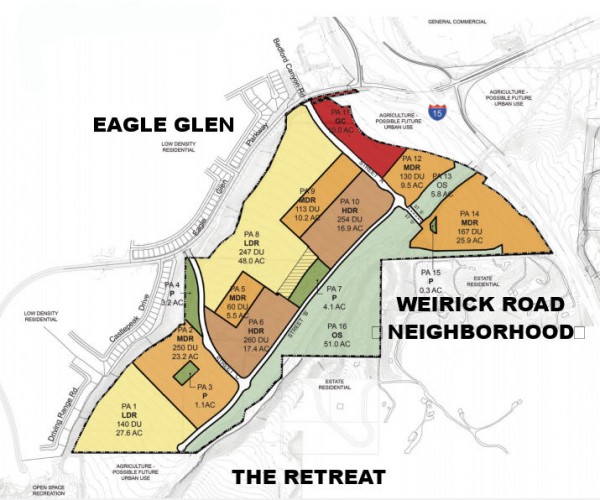
1,806 HOMES: This is the development plan for Arantine Hills. The property currently is being graded.
Corona City Council OKs Arantine Hills
(Published May 23, 2016)
The Corona City Council at its May 19 meeting approved the 1,800-home Arantine Hills project. The development agreement between the city and developer New Home Company allows homes to be built prior to improvements made to the Cajalco interchange. Grading for the housing project is expected to start immediately.
The first 308 homes could be ready for sale mid-2017 — the same time improvements to the bridge are expected to begin. The development agreement also allows the possibility of 1,300 homes being constructed before the interchange project is half finished.
MORE INFORMATION
View the meeting HERE
Related Press-Enterprise report:
Vote paves way for nearly 2,000-home Arantine Hills project
City Council to vote on Arantine Hills
(Published May 4, 2016)
The fate of the 1,800-home Arantine Hills project should be determined at a Corona City Council public hearing, 6:30 p.m., Thursday, May 19 at City Hall, 400 S. Vicentia Ave.
The public can comment on the project at the meeting, with statements not to exceed three minutes. Comments also can be emailed to City Clerk Lisa Mobley at lisa.mobley@ci.corona.ca.us and must be received no later than Tuesday, May 17.
MORE INFORMATION
Public Hearing Notice
Commission says ‘yes’ to Arantine Hills
(Published April 26, 2016)
The Corona Planning Commission gave thumbs up to the 1,800-home Arantine Hills Development following a public hearing on April 25, and will recommend the project’s approval to the City Council.
Nineteen people spoke at the hearing — five people were in favor of the project and the remaining speakers opposed it.
Most of the opposition — primarily Temescal Valley and Eagle Glen residents, was against the plan’s proposal to allow 308 homes to be built before construction begins on improvements to the Cajalco interchange.
The Development Agreement between the city and New Home Company, the developer, outlined how building permits/certificates of occupancy will be issued. After the first 308 homes are built and bridge improvements begin, 600 more permits will be issued, 390 more permits will be issued when the bridge is 50 percent complete and the rest of the permits issued when the bridge construction is 95 percent complete.
Construction should start on the interchange in July 2017 and will take two years to complete.
Riverside County Transportation Department sent Patty Romo to address county concerns, primarily that traffic studies had under-estimated the number of vehicles that would be using Temescal Canyon Road and that funding should be made available for improvements to TCR.
Speakers for the project represented the Building Industry Association, The Crossings, The Shops at Dos Lagos and the Corona Chamber of Commerce, which favored homes and less commercial/retail.
City staff, in presenting the project to the planning commissioners, recommended approval based on the offer by the developer to pay not only its share for the bridge improvements, but to front the entire amount, including the city’s two-thirds share of the estimated $67 million costs.
Staff reasoned that the offer by the developer would enable the improvements to be made sooner, rather than later, because the city does not have the funding to make the improvements.
Staff also said by reducing the amount of commercial acreage from 38 to 10 acres, estimated daily trips would be reduced by 11,000. Staff said this reduction in daily trips would allow 308 homes to be built without impacting traffic.
Eleven people from Temescal Valley attended the hearing. Seven offered comments and voiced concerns about the proximity of the development to the valley’s Weirick Road neighborhood, where zoning allows only one home per five acres.
All opposing arguments addressed gridlock on the I-15 and surface streets, and some questioned the timing of the project with the 1-15 toll lanes construction set to begin in 2018. The resounding message voiced by the opponents was to “Build the bridge first.”
The Corona City Council will vote on the project following another public hearing, possibly scheduled at its Thursday, May 19 meeting.
MORE INFORMATION
DEVELOPMENT AGREEMENT
Video of Planing Commission Public Hearing
Related Press-Enterprise report:
Arantine Hills gets nod from Planning Commission
Arantine Hills hearing is April 25
(Published April 13, 2016)
A Planning Commission public hearing for the Arantine Hills development will be held at 6 p.m., Monday, April 25 at Corona City Hall, 400 S. Vicentia Ave. People who have opinions either for or against the changes and can’t make the April 25 hearing can email their comments prior to April 21 to city planner Terri Manuel at terrim@ci.corona.ca.us
The project is located west of the I-15 in the Bedford Wash between Eagle Glen and the northern boundary of Temescal Valley. The 1,806-home development was approved by the city in July 2012. New Home Company, which purchased the development from Bluestone Communities after the city’s approval, is asking for changes to what was originally approved, creating the need to amend the specific plan and modify the environmental impact report.
The amended specific plan and modified environmental impact report, as well as documents outlining the project’s 2012 approval can be found at http://discovercorona.com/City-Departments/Community-Development/Planning-Division/Arantine-Hills-Project.aspx After hearing comments from the public and city staff at the April 25 hearing, planning commissioners are expected to vote on the project as a recommendation to the City Council whether to approve or deny the changes. The City Council, at a future public hearing, will make the ultimate decision on changes to the project.
Comments sought on changes to Arantine Hills documents
(Published Feb. 13, 2016)
The city of Corona is accepting comments on the Arantine Hills amended specific plan and draft supplemental environmental impact report. The deadline to submit comments is Monday, Feb. 22.
The project is located west of the I-15 in the Bedford Wash between Eagle Glen and the northern boundary of Temescal Valley. The 1,806-home development was approved by the city in July 2012.
New Home Company, which purchased the development after the city’s approval, is asking for changes to what was originally approved, creating the need to amend the specific plan and modify the environmental impact report.
Notable changes include a reduction in general commercial acreage from 38 to 10 acres, increasing open space from 36.6 to 56.8 acres, reducing parkland from 15.2 to 8.7 acres and deleting from the plan a recreational trail and bikeway that would have been available for public use outside the gated community.
Additionally, the developer wants to construct 308 homes before construction starts on improvements to the Cajalco interchange, and once bridge construction begins, homes could continue to be built. The 2012 approval was conditioned on bridge improvements being completed prior to building permits being issued.
Total cost of the bridge improvement is about $62 million with New Home Company being responsible for one-third. If allowed to build homes prior to the improvements, New Home Company will advance the entire amount including the city’s share. While New Home Company can pay its share of about $21 million, the city says it has no funds available to pay for the remaining $41 million.
A development agreement between the city and New Home Company will outline how the city will repay the advanced funds for the improvement. City staff, in May, told the City Council the bridge was over capacity now, and the costs to make improvements would only increase the longer it takes to correct the problem. Staff also told the council no money in paybacks would come from the city’s general fund.
Temescal Valley residents, as well as Corona residents living in Eagle Glen, are citing concerns about school overcrowding and additional gridlock to the I-15 caused by homes being built prior to interchange improvements being made. Additional concerns are keeping open the access to the Bedford Wash hiking trails and the proximity of proposed medium density homes to the estate-zoned parcels (one home per five acres), in the Weirick Road neighborhood.
People are questioning why New Home Company would purchase the approved project knowing the conditions of the approval and the stipulation that no homes could be built prior to interchange improvements being completed.
Comments should be emailed prior to Feb. 22 to city planner Terri Manuel at terrim@ci.corona.ca.us. The dates for public hearings have yet to be determined.
MORE INFORMATION
Amended Specific Plan & Draft Supplemental Environmental Impact Report
Project Fact Sheet
About the project
Related Press-Enterprise reports:
June 19, 2015: Developer revises Arantine Hills plan
Jan. 9, 2015: Huge proposed housing project faces obstacles
Aug. 6, 2014: Corona housing develpment back on the drawing board
Arantine Hills back on drawing board
(Published June 14, 2015)
The city of Corona held two meetings in May with New Home Company, the developer who wants to make changes to the plans for Arantine Hills, the 1,600-plus home development approved by the city in July 2012. The project is located west of the I-15 in the Bedford Wash between Cajalco Road and the northern boundary of Temescal Valley.
New Home company, which purchased the development after the city’s approval, is asking for considerably less commercial retail acreage and wants to start building the homes at the same time construction begins on improvements to the Cajalco interchange. The 2012 approval was conditioned on bridge improvements being completed prior to homes being built.
During the May meetings, New Home Company told City Council members they are willing to build a smaller retail center — 80,000 square feet, outside the community’s gates at Eagle Glen Parkway and Bedford Canyon Road. New Home said there would be no family apartments, but when questioned further, said there could be senior apartments which could bring the housing total up to 1,800-plus.
In the original agreement, the developer was responsible for funding one-third of the costs for the bridge improvement — the total cost today being about $62 million. New Home now has offered to advance the entire $62 million if the city will allow construction on the bridge and the homes to begin simultaneously. While New Home can pay its share of about $21 million, city staff said there were no funds available to pay for the remaining $41 million.
If the city accepts the offer, a development agreement between the city and New Home Company will outline how the advanced fees will be repaid. City staff said the bridge was over capacity now, and the costs to make improvements would only increase the longer it takes to correct the problem. Staff also told the council no money in paybacks would come from the city’s general fund.
Temescal Valley residents speaking at both meetings cited concerns about school overcrowding, gridlock, keeping access to the Bedford Wash hiking trails open and the proximity of proposed homes to the estate-zoned parcels (one home per five acres), in the Weirick Road neighborhood.
A Weirick Road resident, whose home would be adjacent to proposed homes in the project, said he owns many horses and doesn’t want complaints about noise, odors and flies from Arantine Hills residents.
The city made it clear to the developer that it must meet with area residents to discuss their concerns. An open meeting has been scheduled 6 to 8 p.m., Monday June 15 at the Eagle Glen Golf Club’s Monument Room, 1800 Eagle Glen Parkway. LEARN MORE ABOUT THE PROJECT
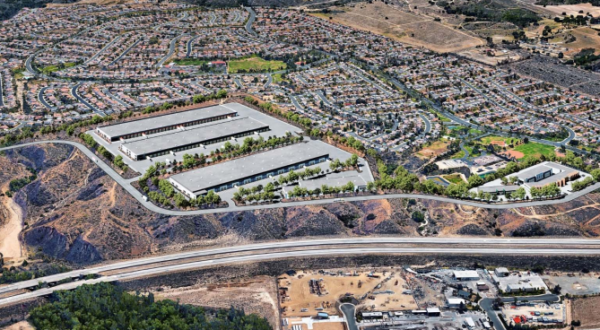
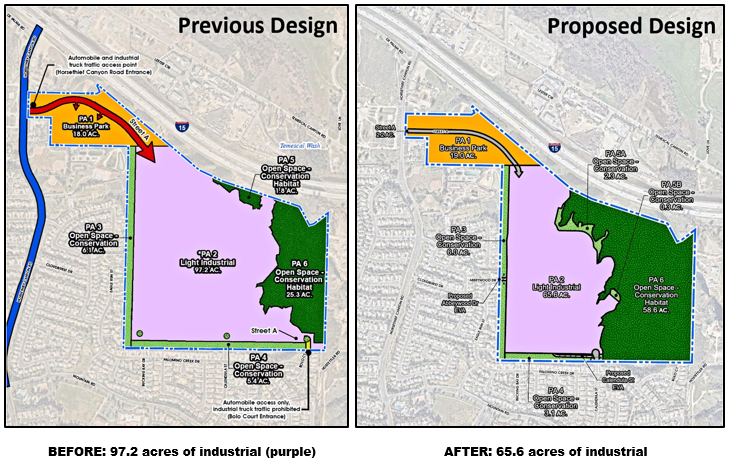
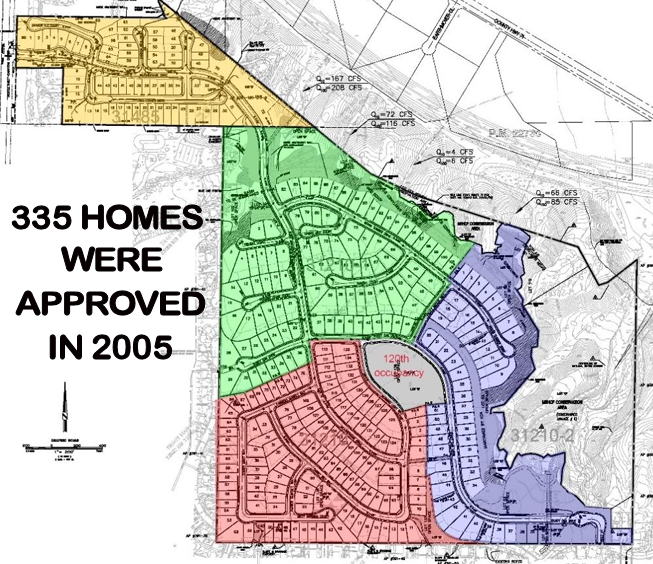

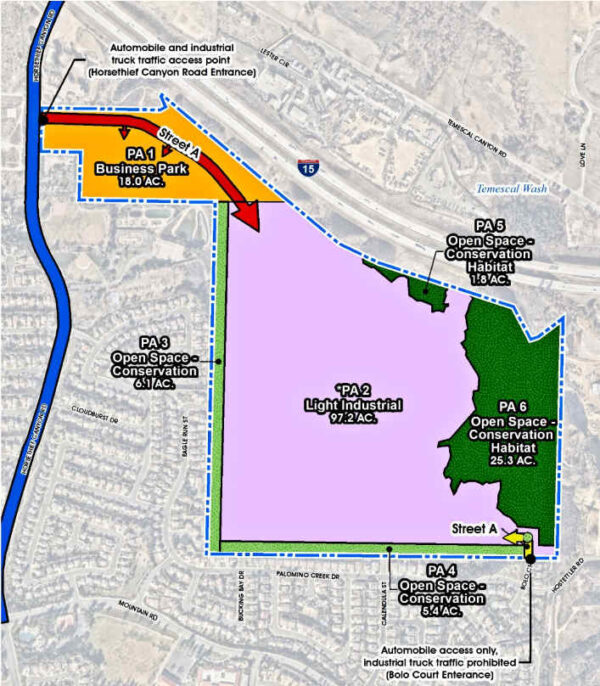
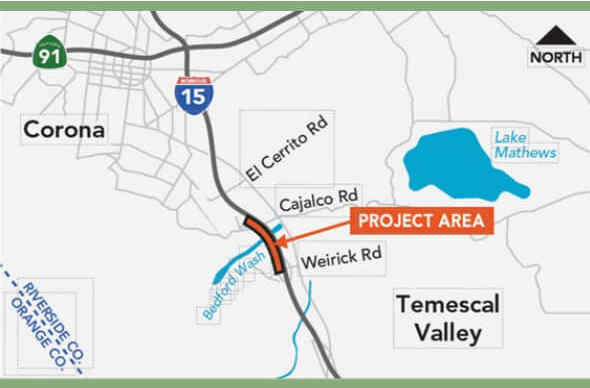
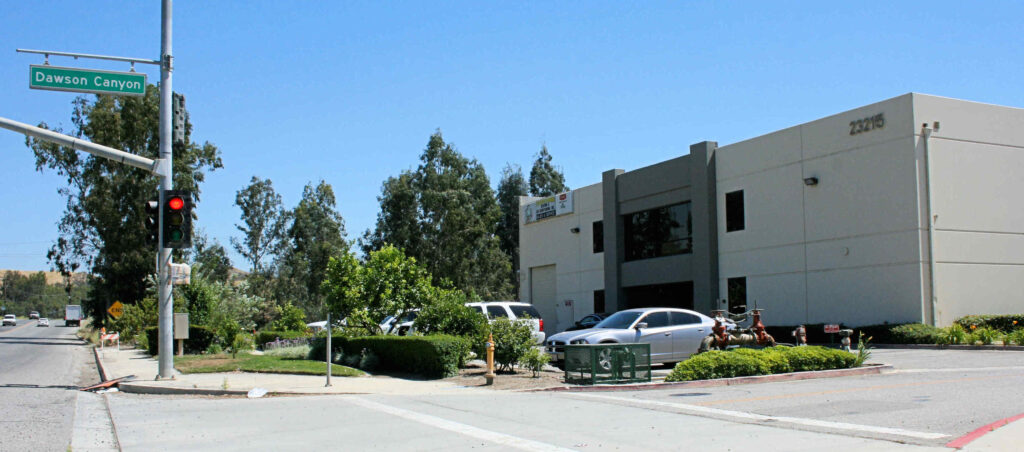



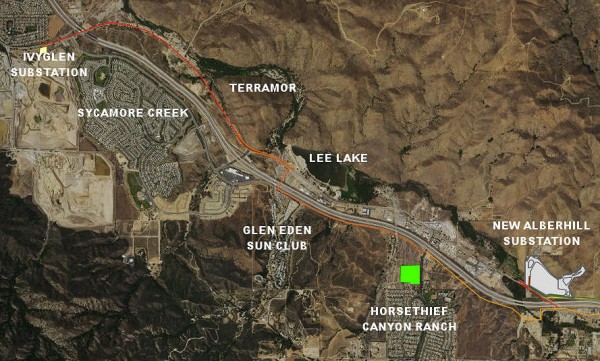
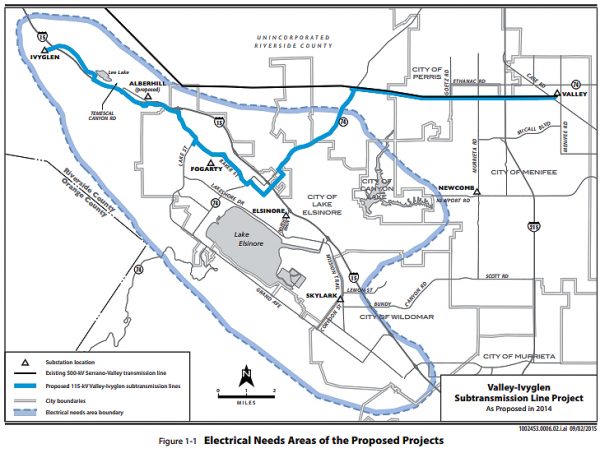
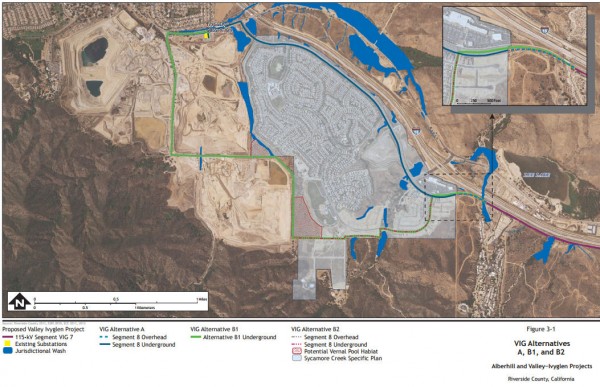 VIG Alternative A would alleviate the necessity for the line to cross the I-15 by extending it north from Glen Eden for another 2,000 feet. The line would be undergrounded at the south end of the Vons Shopping Center, continue down Campbell Ranch Road to Temescal Canyon Road to the IvyGlen substation. Two other alternatives – B1 and B2, running above and below ground through Sycamore Creek along Santiago Canyon Road to Maitri Road, do not reduce the proposed project’s impacts.
VIG Alternative A would alleviate the necessity for the line to cross the I-15 by extending it north from Glen Eden for another 2,000 feet. The line would be undergrounded at the south end of the Vons Shopping Center, continue down Campbell Ranch Road to Temescal Canyon Road to the IvyGlen substation. Two other alternatives – B1 and B2, running above and below ground through Sycamore Creek along Santiago Canyon Road to Maitri Road, do not reduce the proposed project’s impacts.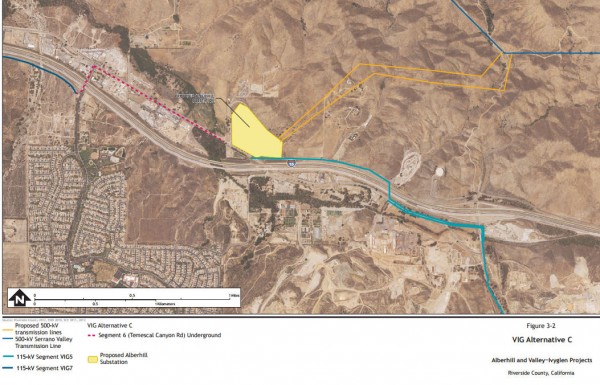 Instead of crossing to the west side of the I-15 from the proposed Alberhill substation, VIG Alternative C would keep the line on the east side of the freeway running underground along Temescal Canyon Road to Horsethief Canyon Road, turning west under the I-15 and rising above ground at De Palma Road.
Instead of crossing to the west side of the I-15 from the proposed Alberhill substation, VIG Alternative C would keep the line on the east side of the freeway running underground along Temescal Canyon Road to Horsethief Canyon Road, turning west under the I-15 and rising above ground at De Palma Road.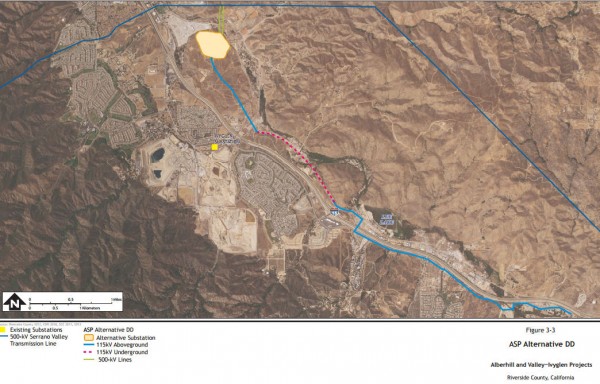 ASP Alternative DD relocates the substation to property within the Serrano Specific Plan. Approved by the county in 2010, the 489-acre Serrano Commerce Center is zoned for light industrial, commercial retail and open space. The property is on the east side of the I-15 and stretches from Temescal Canyon Road on the north to Temescal Canyon Road on the south adjacent to the freeway underpass. Development of the property never began and was further waylaid by the recession.
ASP Alternative DD relocates the substation to property within the Serrano Specific Plan. Approved by the county in 2010, the 489-acre Serrano Commerce Center is zoned for light industrial, commercial retail and open space. The property is on the east side of the I-15 and stretches from Temescal Canyon Road on the north to Temescal Canyon Road on the south adjacent to the freeway underpass. Development of the property never began and was further waylaid by the recession.